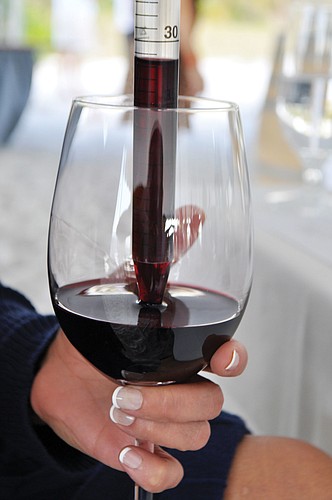- November 27, 2024
-
-
Loading

Loading

A person would have to travel to Massachusetts, Oregon, New York, California and eight countries in only two days to experience something similar to Sarasota’s Bacchus on the Beach.
The Longboat Key Club and Resort brought wineries, winemakers and experts from around the world together Nov. 9 and Nov. 10, to offer a unique foodie experience.
More intimate events were offered throughout the weekend in addition to the grand finale, the Wine & Stone Crab Festival sunset dinner. There were five vintner dinners with menus from Key Club chefs, paired with wine from guest winemakers. And there were also three demonstrations that taught the average person how to become a wine expert.
One of the demonstrations was a blending class led by Michael DeLoach, of Sonoma’s Hook & Ladder Vineyards, Nov. 10, on the beach. Attendees learned the art of blending wines and then had the chance to blend their own bottle.
Chemistry of wine
The blending class drew everyone from resort guests, to wine enthusiasts, to a winemaker from France.
DeLoach is the second generation of winemakers at Russian River Valley’s Hook & Ladder Vineyards. Before jumping into the blending seminar, DeLoach explained his family’s history:
It date backs to 1970 when DeLoach’s father, San Francisco fireman Cecil DeLoach, bought the first 24 acres of what would expand to 900 acres of land. As a fireman, Cecil DeLoach worked 24 hours on, followed by 48 hours off. During his time off, he opted to grow grapes.
In honor of his career as a tillerman (the firemen who ride on the back of the truck), Cecil DeLoach created a blend called The Tillerman.
DeLoach told the group it’s important that every blend has a muse.
“Now smell it,” he said. The Cabernet-based blend leaves notes of spiced cherry.
He then talked about the four other varieties the winery offers and outlined a personality profile of wine-lovers: Sangiovese-lovers are classy, and people either love or hate the Franc — those who like it are strong-willed.
After sampling, the group recreated The Tillerman blend, made from each of the sampled wines.
Using a mouth-controlled pipette, individuals drew the correct measurement of each of the four wines into the tube and filled a beaker to 100 milliliters to recreate The Tillerman blend.
“It sucks to be a winemaker,” DeLoach joked.
Making it her own
A&E Editor Mallory Gnaegy shares her experience of “blending in” while creating her own wine at the demonstration.
The first step in creating a new wine blend is creativity — which is probably the easiest step for me. What should my muse be?
One attendee said “sand and waves,” and another said “crazy.” I went with “after deadline,” because that’s when a glass of wine feels most deserved — and tastes the best.
During the seminar, we were told to attempt to create our own wine blend, and if it turned out bad to dump it, or drink it, and try again.
The base of the blended wine would be the highest percentage of the wines used — about 40% to 50%.
I listed the four wines I wanted to use, in order of favorite, then determined how much of each I wanted to use.
After Deadline would contain 50 milliliters of Cabernet Sauvignon, 25 milliliters of Sangiovese, 15 milliliters of Merlot and 10 milliliters of Cabernet Franc.
Mistake one: I picked up my glass of The Tillerman by mistake and blended it with the 25 milliliters of Sangiovese, so I had to drink it and start over — darn!
The second attempt at making my blend was successful, so I filled my bottle.
Aside from measuring, the hardest part was trying not to spill the wine. My placemat was splashed with red by the time I was finished. Luckily, what wasn’t spilled turned out well. And after my deadline, it was even more delicious.